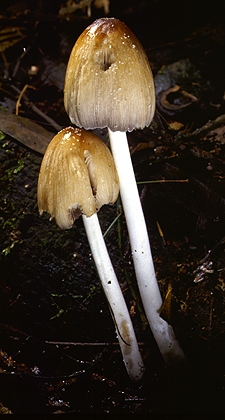
Coprinus truncorum (Schaeff.) Fr.

Common name: None.
Description: The caps are 14 cm in diameter and are at first parabolic, but then expand to broadly convex. The surface is dry and brown but covered at first by large numbers of small, white powdery particles (especially at the centre); these steadily disappear as the cap ages. The margins are plicate, and the gills are at first white, but they become brownish and finally black. The white, smooth dry stems are 410 cm long and about 3 mm thick, and they lack a ring. The gills and caps begin to autodigest enzymatically once the gills have matured and become black. After about 36 hours, all that remains are the stems with the shrivelled, messy, inky black cap remnants adhering to their apices.
The spores are 710 × 46 µm, ellipsoidal, smooth, black and have a germ pore.
Substrate: Coprinus truncorum is always found on or near buried wood and usually in large clusters.
Distribution: Known from Queensland, New South Wales, Victoria and Tasmania.
Notes: This species is common in its range and is very attractive in its early stages. Australian material of Coprinus truncorum has frequently been identified as the European Coprinus micaceus from which it is almost indistinguishable macroscopically. The stems of C. truncorum are reported to be smoother than those of C. micaceus but this character is also said to be unreliable. Microscopically, the two species are easily separated on spore shape: spores of C. truncorum are always more or less ellipsoidal in outline, but at least some spores of C. micaceus will display a submitriform (weakly resembling a bishops mitre) outline.

